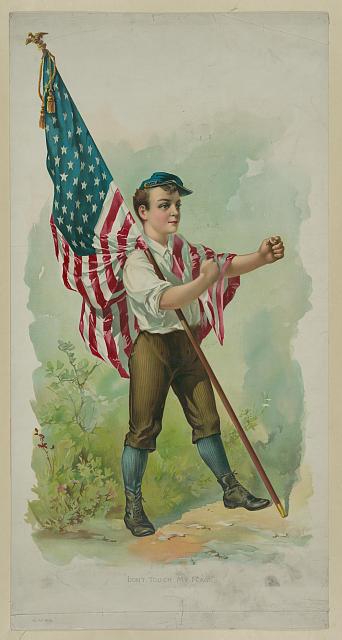
Image Credit: "Don't Touch My Flag," Library of Congress Prints and Photographs
Greetings, all. In my last post for this semester, I'd like to continue on the poetry track down which I've been more or less rambling. Lately, I've noticed the growing frequency with which both poets and larger institutions are using visual media to bring poetry to broader (usually younger) audiences and to augment the form of the reading experience. I've also thought about how some of these techniques can be added to my own pedagogical practices.
In that frame of mind, I've put together a short piece using iMovie and images from the Library of Congress's Prints and Photographs collection to accompany my reading of Donald Revell's poem "Election Year." The clip models an exercise I'd like to use in the classroom in the future.
I'm interpreting the poem as indicating the speaker's willingness to be outside of all of the "Americanisms" an election year might evoke. However, the title emphasizes the weight of a nationalistic, mass culture that is difficult to escape. Consequently, because the poem's title arouses and insists on what the rest of the poem deliberately eschews, the poem is about what it is not about, if that makes sense. To emphasize such a contradiction, I've chosen a series of images that are highly saturated with associations of patriotism, protest, and significant events in U.S. history. Included in the clip are a photograph of Lincoln's funeral, a shot of listeners at a Civil Rights-era protest, an image of a group meeting in an Arizona labor camp, and a photograph of the Wright Brothers' first flight at Kitty Hawk.
In a literature class, students could produce similar videos using images from the databases that we have listed on our "images" section of the blog. Students could be instructed to take multiple approaches, using images to interpret a poem, to historicize it, or a mixture of both. The exercise might be modified to allow students to use images of their own making in interpeting a poem. The latter approach could be particularly fruitful for a creative writing workshop in which students could produce docu-poems similar to these. Students would be asked to give a presentation and/or produce a short essay with a bibliography to accompany their pieces.
Significantly, as much as the exercise focuses on images, it also requires students to read the piece aloud, which is a practice that should be emphasized in any teaching of poetry.

Recent comments
2 years 29 weeks ago
2 years 44 weeks ago
2 years 44 weeks ago
2 years 50 weeks ago
3 years 4 weeks ago
3 years 4 weeks ago
3 years 4 weeks ago
3 years 6 weeks ago
3 years 6 weeks ago
3 years 6 weeks ago